Medieval guild artisans preserved ancient jewelry-making traditions through structured apprenticeship programs that lasted five to nine years under master craftsmen. You’ll find these guilds emerged in the 12th century, establishing rigorous quality standards through hallmarking systems and touchstone testing techniques inherited from Egyptian and other ancient civilizations. They controlled luxury adornment production while maintaining strict purity standards for gold and silver work. Their legacy continues influencing modern jewelry making through traditional apprenticeships and collaborative craftsmanship methods that reveal fascinating connections across centuries.
Origins and Formation of Medieval Artisan Guilds
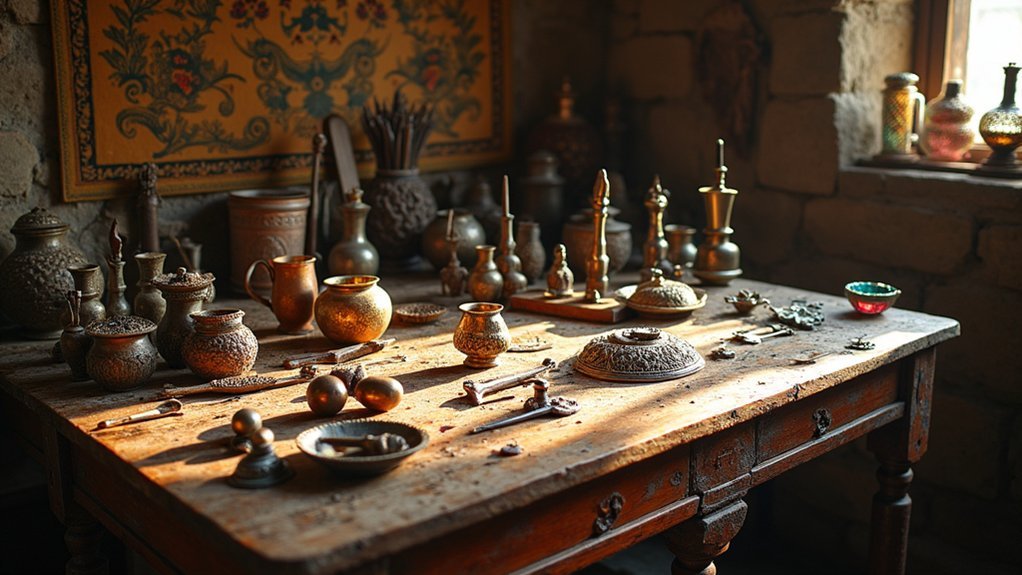
While Europe emerged from the early medieval period, craftsmen in the 12th century began organizing themselves into structured groups that would revolutionize urban commerce.
You’d find these guilds forming as weavers, bakers, and other artisans recognized they needed collective strength to protect their interests and maintain production standards. The term “guild” comes from the Saxon word “gilden,” meaning to pay or yield, which perfectly captures how these organizations emphasized mutual aid and economic cooperation among members.
When you examine their formation, you’ll see that guilds weren’t casual associations. They developed sophisticated hierarchical structures with senior members called wardens who handled quality control, resolved disputes, and negotiated with local authorities, establishing the foundation for medieval urban economic systems.
The Guild System’s Role in Preserving Ancient Craft Knowledge
Beyond their organizational prowess, guilds became the guardians of centuries-old craftsmanship that might otherwise have vanished during medieval Europe’s turbulent transformations.
You’ll find that craft guilds established structured apprenticeship programs where masters carefully transmitted specialized knowledge to apprentices and journeymen. This hierarchical system guaranteed skill mastery and maintained traditional techniques across generations.
These organizations regulated production standards through written rules, like those governing the Hatter’s Guild, preventing ancient methods from deteriorating amid changing economic conditions.
You can see how guilds upheld consistency and quality while safeguarding ancestral processes from decline. Additionally, they provided welfare support for members facing hardships, creating stable artisan communities that preserved their inherited skills and traditional crafting knowledge.
Goldsmith Guilds and Precious Metal Working Traditions
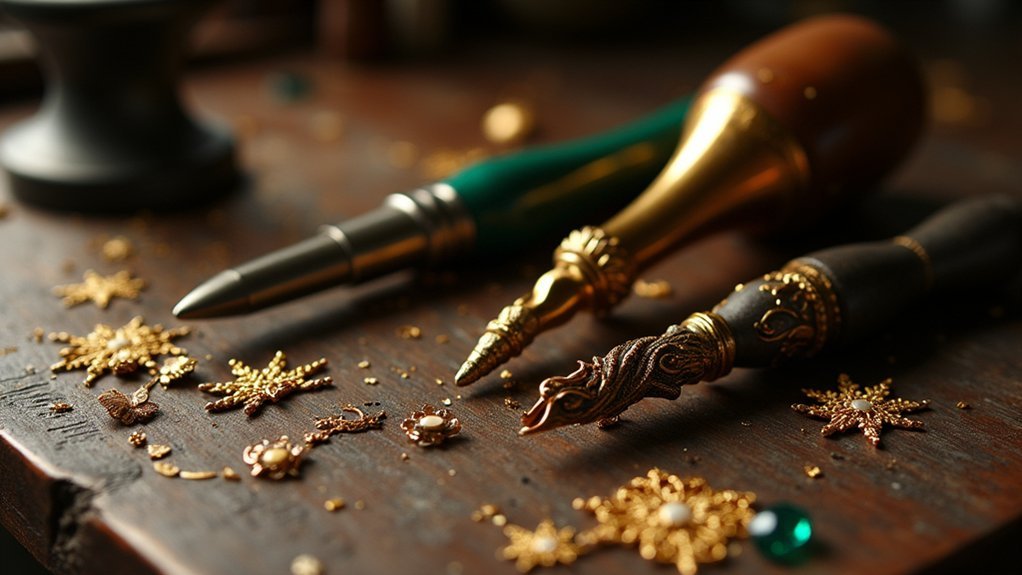
You’ll find that goldsmith guilds established rigorous training standards through structured apprenticeship systems, where aspiring craftsmen spent years mastering techniques under experienced masters before advancing to journeymen and eventually achieving master status themselves.
These guilds didn’t just focus on technical skills—they embedded deep symbolic meaning into sacred metalwork, creating religious artifacts and ceremonial items that carried spiritual significance beyond their material value.
Your understanding of medieval craftsmanship expands when you recognize how these institutions maintained strict quality controls through official marks and stamps, ensuring that precious metal purity met established standards while preserving ancient working traditions.
Guild Training Standards
Although apprenticeships in most medieval trades required dedication, goldsmith guilds demanded an extraordinary five to nine years of intensive training that surpassed nearly every other craft.
You’d learn through hands-on experience under master goldsmiths’ careful guidance, observing every technique and absorbing trade secrets through daily practice.
Your training wouldn’t end with time served—you’d need to create a masterpiece demonstrating your skills and adherence to guild quality standards.
Existing masters would evaluate your work, determining whether you’d earned the right to practice independently. This rigorous assessment guaranteed only skilled artisans achieved guild membership.
You’d master not just metalworking techniques, but also understand precious metal regulations, gemstone standards, and the intricate requirements for creating religious and ceremonial pieces that reflected clients’ socio-economic status.
Sacred Metalwork Symbolism
When goldsmith guilds crafted sacred objects, every decorative element carried profound spiritual meaning that transcended mere artistic beauty. You’d find that chalices bore intricate engravings representing Christ’s sacrifice, while reliquaries displayed detailed filigree work symbolizing divine protection. Sacred metalwork served as both devotional tool and status symbol within medieval communities.
Guilds became guardians of these symbolic traditions, ensuring apprentices mastered not just technical skills but understood the religious significance behind each design choice.
You’d see crosses adorned with precious stones representing the twelve apostles, or baptismal fonts featuring flowing patterns symbolizing eternal life. Every piece reflected the community’s faith while demonstrating the goldsmith’s spiritual understanding and artistic mastery within guild standards.
Apprenticeship Programs for Jewelry Making Arts
Since medieval jewelry making demanded exceptional skill and precision, young apprentices commenced on rigorous training programs that stretched between five to nine years under a master jeweler’s watchful eye.
Medieval apprentices endured five to nine years of intensive training under master jewelers to master their demanding craft.
You’d receive room and board in exchange for your labor, starting with menial tasks before advancing to intricate techniques. Medieval Guilds strictly regulated this progression, ensuring quality standards were maintained throughout your training.
Upon completing your apprenticeship, you’d become a journeyman and could charge for work. However, achieving master status required creating a masterpiece judged by guild members.
Competition and economic pressures sometimes sparked conflicts among apprentices and tradesmen. These social dynamics reflected the intense environment within jewelry-making guilds, where your success depended on both technical mastery and maneuvering through complex professional relationships.
Master Craftsmen and the Creation of Ceremonial Adornments
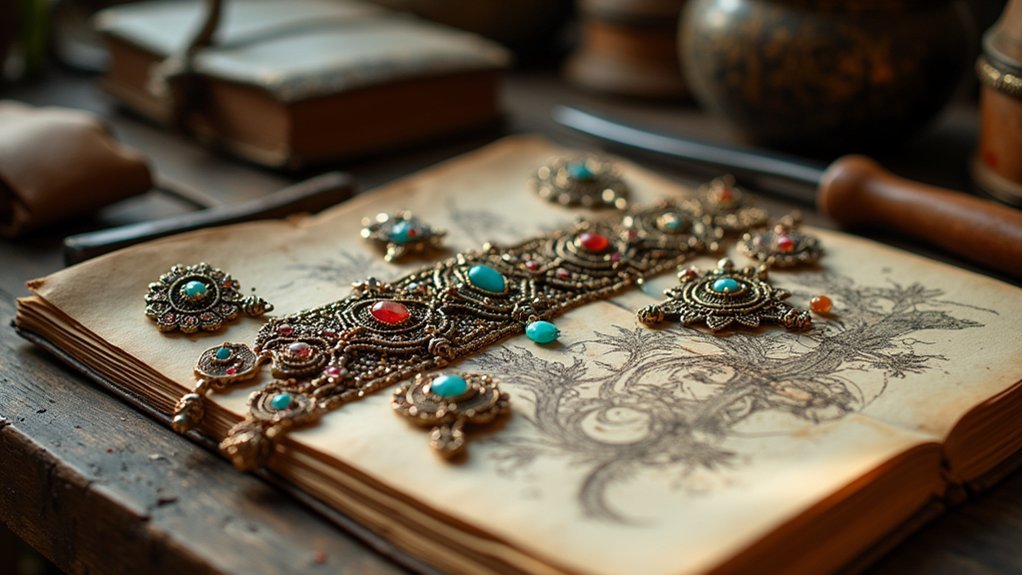
After achieving master status, you’d find yourself at the pinnacle of medieval craftsmanship, responsible for creating the most prestigious ceremonial adornments that defined social hierarchies and cultural identity. Master craftsmen worked within small family workshops, collaborating on intricate pieces using precious metals and gems that reflected their clients’ socio-economic standing.
| Workshop Role | Primary Materials | Specialization | Quality Control | Timeline |
|---|---|---|---|---|
| Goldsmith | Gold, silver | Metal shaping | Guild inspection | 2-6 months |
| Gem-setter | Precious stones | Stone mounting | Material verification | 1-3 months |
| Engraver | Various metals | Surface detailing | Pattern approval | 2-4 weeks |
| Polisher | Abrasive compounds | Finishing work | Final assessment | 1-2 weeks |
| Designer | Parchment, ink | Pattern creation | Concept review | 1-4 weeks |
You’d adhere to strict guild regulations governing materials and techniques while creating masterpieces that showcased advanced skills.
Quality Standards and Regulation of Precious Materials
You’ll find that medieval guilds implemented rigorous authentication methods to verify the quality and origin of precious materials used in their workshops.
They established strict purity controls for precious metals, requiring artisans to meet exact standards for gold and silver content in their creations.
Your understanding of guild oversight reveals how wardens conducted regular inspections of artisan workshops, ensuring compliance with these material regulations through systematic quality checks.
Guild Material Authentication Methods
When you examine medieval guild operations, you’ll discover that material authentication formed the backbone of their quality control systems.
Guild members developed sophisticated methods to verify precious materials and prevent counterfeiting in luxury crafts.
Their authentication arsenal included:
- Hallmarking stamps – Goldsmiths pressed unique marks into metals, creating permanent signatures of purity and origin.
- Touchstone testing – Artisans scraped gold against dark stones, comparing color streaks to determine metal content.
- Weight verification scales – Precision instruments measured materials against standardized guild weights.
- Fire assay techniques – Controlled heating processes revealed true metal composition through oxidation patterns.
Guild wardens conducted surprise inspections, examining these authentication markers while reviewing detailed production records.
You’d face severe penalties, including expulsion, for using substandard materials or falsifying authentication marks.
Precious Metal Purity Controls
While authentication methods provided the foundation for quality control, guilds implemented even more rigorous purity controls that governed the exact composition of precious metals used in their crafts.
You’d find these organizations establishing strict quality standards that guaranteed artisans adhered to precise regulations regarding material purity and composition. Guild inspectors regularly tested precious metals to verify compliance, protecting you from fraudulent practices.
They required hallmarks or stamps on finished goods, assuring both craftsmanship quality and material integrity. If you violated these purity regulations, you’d face severe consequences including hefty fines, expulsion from guild membership, and irreparable damage to your reputation within the artisan community.
These controls maintained consumer trust and industry standards.
Artisan Workshop Quality Oversight
Beyond material purity, guilds extended their regulatory reach into every aspect of workshop operations through thorough quality oversight systems.
This artisan workshop quality oversight guaranteed every guild member maintained exceptional standards throughout their craft production.
You’d encounter strict monitoring through:
- Regular inspections – Guild officials examined your workshop tools, materials, and finished pieces without warning.
- Masterpiece submission – You couldn’t become a master one without demonstrating superior craftsmanship through a flawless creation.
- Written production guidelines – The Hatter’s Guild exemplified this with detailed rules governing quality and timing standards.
- Enforcement penalties – Violations resulted in hefty fines or membership expulsion, destroying your trade prospects.
Members who consistently delivered high quality work thrived under this system, while those cutting corners faced swift consequences that could end their careers permanently.
Religious Symbolism in Guild-Produced Ornaments
As medieval guild artisans perfected their craft, they wove deeply sacred meanings into every ornament they created, transforming simple decorative objects into powerful vessels of faith. You’d find religious symbolism embedded in every piece, from crosses representing salvation to angels symbolizing divine protection. When you examine guild-produced ornaments, you’ll notice how artisans used precious materials like gold and gemstones to emphasize spiritual significance.
| Religious Motif | Sacred Meaning |
|---|---|
| Crosses | Divine sacrifice and redemption |
| Angels | Heavenly messengers and protection |
| Saints | Intercession and spiritual guidance |
| Doves | Holy Spirit and peace |
| Lilies | Purity and resurrection |
These artisans created bespoke items for churches and wealthy patrons, ensuring each chalice, reliquary, and vestment met sacred standards while serving both devotional and ceremonial purposes.
Trade Networks and Access to Gemstones and Metals
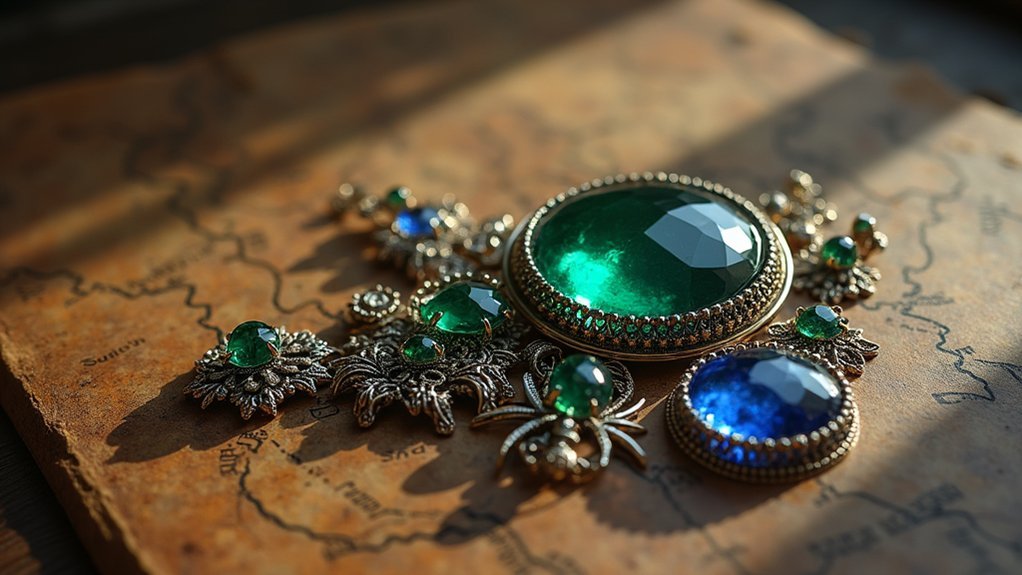
You’ll find that medieval guild artisans couldn’t create their finest works without accessing extensive trade networks that connected Europe to distant regions rich in precious materials.
These guild trade routes, including the famous Silk Road, brought you everything from Afghan lapis lazuli to Middle Eastern turquoise, while major trading hubs like Venice and Constantinople served as essential distribution centers.
You’d see artisans working closely with merchants to secure high-quality gemstones and metals, ensuring their craft guilds maintained strict standards for material authenticity and sourcing.
Guild Trade Routes
Veins of commerce stretched across medieval Europe like arteries pumping lifeblood into guild workshops, carrying precious gemstones and metals from distant lands to local artisans’ benches.
You’d find merchant guilds orchestrating these complex networks, establishing monopolies that guaranteed quality materials while controlling prices. These organized trading practices created reliable supply chains that artisans desperately needed.
Major routes included:
- The Silk Road – delivering exotic gems and precious metals from Asia
- Mediterranean maritime paths – connecting North African gold mines to European workshops
- Alpine passes – carrying silver from German territories to Italian craft centers
- Baltic Sea routes – transporting amber and Nordic metals southward
As the middle class expanded, you’d witness specialized routes emerging specifically to serve guild artisans’ growing demands for luxury materials.
Precious Material Sources
When medieval guild artisans sought the finest materials for their masterworks, they’d turn their eyes beyond Europe’s borders to distant lands where emeralds sparkled in Colombian mountains and sapphires gleamed in Ceylon’s riverbeds.
You’d find these craftsmen establishing partnerships with specialized merchants who navigated the Silk Road and Mediterranean routes, importing gold from Africa and silver from Germanic territories.
Since local precious material sources couldn’t satisfy growing demand, you’d witness the rise of merchant guilds regulating these trade practices.
These artisans didn’t simply choose materials for beauty—they’d select gemstones and metals believing in their metaphysical properties, incorporating ancient spiritual beliefs into their adornment creations for religious ceremonies and social status displays.
Workshop Organization and Family-Based Craft Businesses
Although medieval craft production might seem like a purely commercial enterprise, workshop organization revolved around the family unit, creating intimate business environments where living quarters and workspaces merged into single, multifunctional buildings.
You’d find master artisans employing their own children and relatives, ensuring trade secrets remained within families while reducing apprenticeship costs. Young males began their training in early teens, spending five to nine years learning essential skills under family supervision.
Guilds strictly regulated these operations, establishing rules for apprentice treatment, work hours, and production quality.
Family workshops operated within guild-defined zones that limited competition and maintained pricing standards:
- Living rooms doubling as design studios
- Kitchen hearths serving as metalworking forges
- Children learning alongside paying apprentices
- Master craftsmen teaching sons advanced techniques
Social Status and Economic Power of Jewelry Guilds
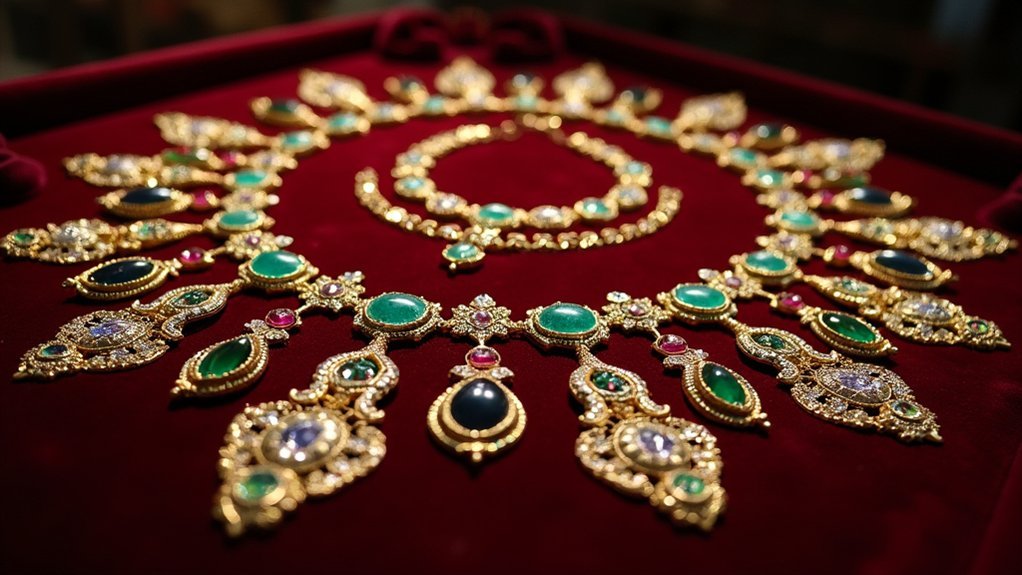
You’ll find that jewelry guilds wielded extraordinary influence through their strict membership requirements, which demanded years of apprenticeship and the creation of a masterpiece before you could earn the coveted title of master jeweler.
These guilds didn’t just control who could practice the craft—they regulated pricing, quality standards, and market access, giving members significant economic leverage over both competitors and customers.
If you were part of these exclusive organizations, you’d occupy a privileged position in medieval society, where your craftsmanship directly translated into social prestige and economic power among the elite.
Guild Membership Requirements
Three demanding requirements stood between aspiring jewelers and guild membership in medieval times. You’d face substantial financial barriers, lengthy training periods, and rigorous skill demonstrations before earning acceptance into these exclusive organizations.
The guild membership requirements created a structured but challenging pathway:
- Financial Investment – You’d pay significant entrance fees that often excluded working-class artisans from participation.
- Extended Apprenticeship – You’d complete five to nine years of intensive training under master supervision.
- Masterpiece Creation – You’d craft an exceptional piece demonstrating your technical skills and artistic vision.
- Sponsor Approval – You’d secure endorsements from established guild members vouching for your character and abilities.
These stringent standards guaranteed only dedicated, skilled artisans gained access to the economic privileges and social status that guild membership provided in medieval society.
Economic Control Mechanisms
Once you gained guild membership, jewelry guilds wielded their economic control through carefully orchestrated mechanisms that protected their interests and maximized profits.
You’d find these organizations maintained strict monopolies over adornment production, preventing outside competition from undercutting established artisans. The guilds controlled pricing structures, ensuring members couldn’t engage in destructive price wars that would devalue their craftsmanship.
You’d witness how these economic control mechanisms extended to material sourcing and quality standards. Guilds monitored gold and gemstone usage, preventing inferior materials from entering the marketplace and maintaining consumer trust.
They’d negotiate collective wages and establish production quotas, creating economic stability for members while controlling market supply. This systematic approach guaranteed jewelry artisans achieved economic independence through structured apprenticeships and protected trade practices.
Social Class Division
While economic control provided the foundation for guild power, the social stratification within jewelry guilds created distinct class divisions that reinforced medieval society’s hierarchical structure.
You’ll find that master jewelers occupied the wealthy elite tier, controlling luxury production and accumulating substantial social capital. Their elevated social status wasn’t accidental—it required significant financial investments and masterpiece completion to achieve recognition.
The guild hierarchy reinforced these divisions through:
- Masters – Wealthy artisans wielding economic power and controlling prestigious jewelry sales
- Journeymen – Skilled workers seeking advancement but lacking full guild privileges
- Apprentices – Entry-level craftsmen serving masters while learning the trade
- Merchant partnerships – Elite collaborations that created medieval cities’ emerging middle class
This structure guaranteed only high-status artisans could produce and sell jewelry, maintaining their privileged position.
Techniques Passed Down From Ancient Civilizations
Although centuries separated medieval guild artisans from ancient craftspeople, the techniques that defined their work remained remarkably connected across time.
You’ll find that medieval artisans inherited specialized metalworking and textile methods from ancient civilizations, emphasizing quality and artistry that’d been refined over generations.
When you examine their lapidary work, you’re seeing Egyptian-influenced stone cutting and polishing techniques that created intricate medieval adornments.
You’d recognize ancient traditions in their beaded collars and ceremonial jewelry, where precious materials conveyed social status and divine symbolism.
Their fabric dyeing and pigment production methods came directly from ancient practices, enabling vibrant colors that reflected cultural significance.
The symbolic motifs and patterns you see in medieval adornments echo ancient designs, demonstrating continuous artistic expression.
Guild Masterpieces and Artistic Excellence Requirements
When medieval guild artisans reached the pinnacle of their apprenticeship, they faced the ultimate test of their abilities: creating a masterpiece that would determine their future within the craft. This wasn’t simply about showcasing technical skills—you’d need to demonstrate complete mastery of traditional techniques while meeting the guild’s exacting standards.
Your masterpiece underwent rigorous evaluation by established guild members who scrutinized every detail for quality and adherence to time-honored methods. The investment required was substantial, demanding:
- Months of dedicated labor using premium materials
- Flawless execution of intricate decorative patterns
- Perfect integration of multiple metalworking techniques
- Innovative design elements within traditional frameworks
Success granted you master status, workshop ownership rights, and the privilege to train apprentices, ensuring your guild’s artistic legacy continued.
Cultural Exchange Through Medieval Adornment Practices
Beyond demonstrating individual mastery, these guild-created works became powerful vessels for cultural exchange that transformed medieval adornment practices across Europe.
You’d witness artisans blending local traditions with distant influences as trade routes expanded their creative horizons. When guild workshops collaborated, they’d exchange precious stones and ornamental techniques that echoed ancient practices, creating pieces that transcended regional boundaries.
You’d find religious and mythological themes from various ancient cultures woven into metalwork and cloth adornments, enhancing their symbolic resonance.
Guild regulations guaranteed these cross-cultural innovations maintained quality standards while preserving historical significance. Through this cultural exchange, medieval artisans didn’t just preserve ancient adornment traditions—they evolved them, creating lasting legacies that reflected Europe’s interconnected medieval world.
Legacy of Guild Traditions in Modern Jewelry Making
While centuries have passed since medieval guilds dominated European craftsmanship, you’ll find their foundational principles deeply embedded in today’s jewelry making industry.
These ancient traditions haven’t disappeared—they’ve evolved into sophisticated systems that maintain the guilds’ core values of excellence and community.
Modern jewelry making preserves medieval guild practices through:
- Structured apprenticeships where novice jewelers train under master craftsmen, learning time-honored techniques through hands-on experience.
- Rigorous quality standards that guarantee materials and craftsmanship meet exacting specifications for product integrity.
- Collaborative teamwork between specialized artisans—designers, gemologists, and metalworkers—creating unified masterpieces.
- Symbolic design elements that incorporate traditional medieval motifs, reflecting cultural significance in contemporary pieces.
Today’s jewelry cooperatives and artisan organizations continue the guild tradition of mutual support and ethical practices.
Frequently Asked Questions
What Did Artisans Do in Medieval Times?
You’d join a guild and complete a lengthy apprenticeship to master your craft. You’d work in family workshops, create goods like metalwork or textiles, follow guild regulations, and eventually produce a masterpiece to become a master artisan.
What Are Guilds and What Role Did They Play in Artistic Practices?
You’d find guilds were organized groups controlling artistic trades through structured apprenticeships, quality standards, and pricing regulations. They elevated artisans’ social status while ensuring craftsmanship excellence through master-journeyman-apprentice hierarchies that dominated medieval artistic production.
What Kind of Rules or Regulations Did Guilds Have for Their Members?
You’d follow strict quality standards for your goods, adhere to set pricing controls, respect hierarchical authority under wardens, support fellow members during hardships, and face fines or expulsion if you violated any regulations.
What Privileges Did Guilds Have?
You’d gain control over production standards and pricing, legal recognition from authorities, tax exemptions, collective bargaining power for wages, internal dispute settlement rights, and access to welfare support during hardships or illness.
In Summary
You’ll find medieval guild traditions still influencing today’s jewelry making. When you’re crafting adornments, you’re following techniques passed down through centuries of apprenticeships. You can’t ignore how these artisans preserved ancient knowledge through their systematic training. Today’s master jewelers continue using methods you’d recognize from guild workshops. You’re witnessing living heritage every time you see hand-forged metalwork or traditional stone-setting techniques in contemporary pieces.

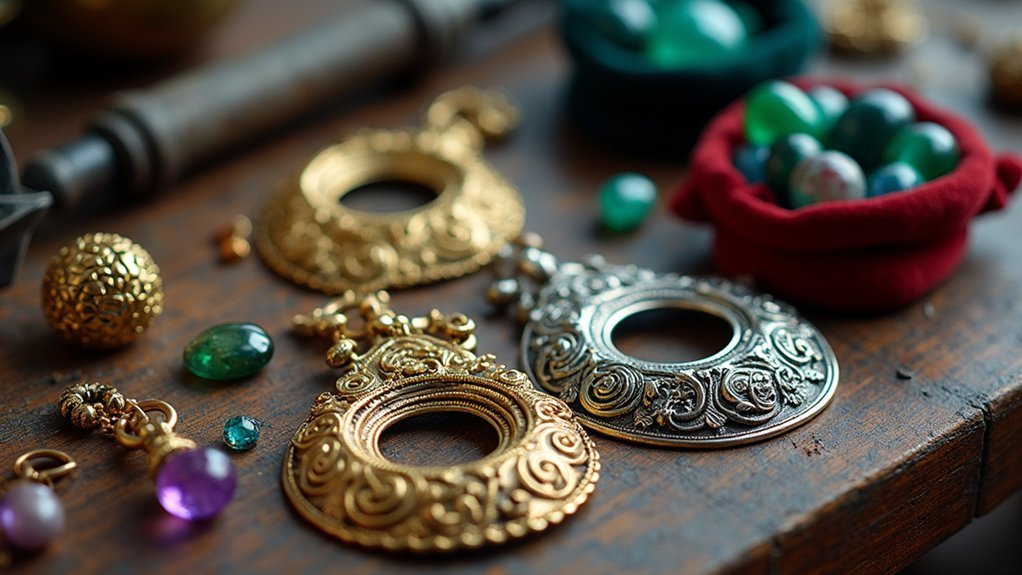
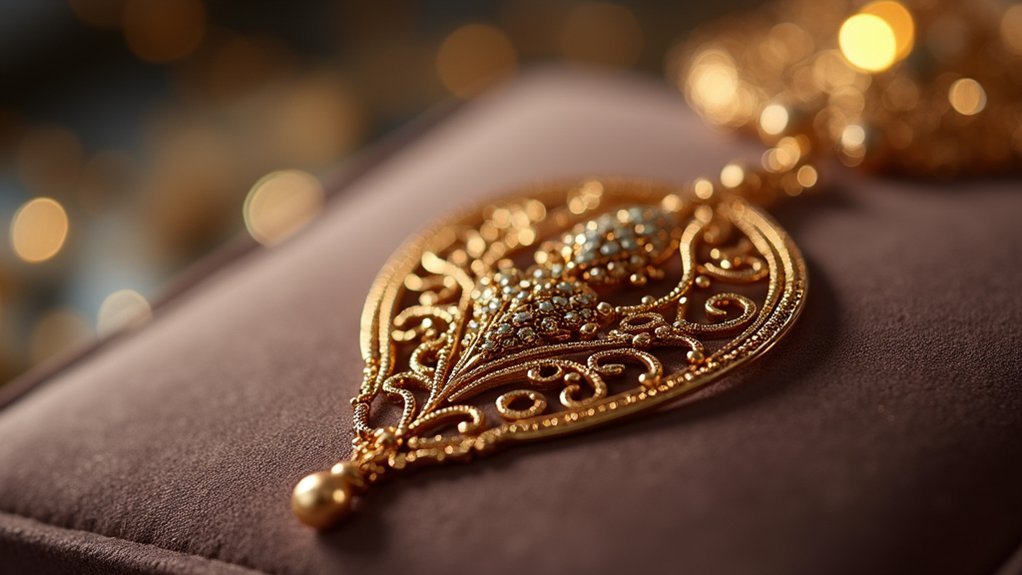


Leave a Reply